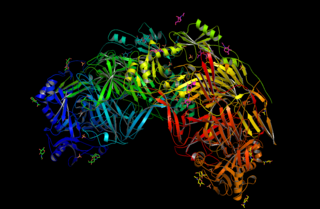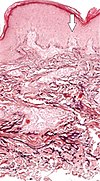Collagen is the main structural protein in the extracellular matrix found in the body's various connective tissues. As the main component of connective tissue, it is the most abundant protein in mammals, making up from 25% to 35% of the whole-body protein content. Collagen consists of amino acids bound together to form a triple helix of elongated fibril known as a collagen helix. It is mostly found in connective tissue such as cartilage, bones, tendons, ligaments, and skin. Collagen makes up 30% of the protein found in the human body. Vitamin E improves the production of collagen.

Elastin is a protein that in humans is encoded by the ELN gene. Elastin is a key component of the extracellular matrix in gnathostomes. It is highly elastic and present in connective tissue allowing many tissues in the body to resume their shape after stretching or contracting. Elastin helps skin to return to its original position when it is poked or pinched. Elastin is also an important load-bearing tissue in the bodies of vertebrates and used in places where mechanical energy is required to be stored.

Elastic cartilage, fibroelastic cartilage or yellow fibrocartilage is a type of cartilage present in the pinnae (auricles) of the ear giving it shape, provides shape for the lateral region of the external auditory meatus, medial part of the auditory canal Eustachian tube, corniculate and cuneiform laryneal cartilages, and the epiglottis. It contains elastic fiber networks and collagen type II fibers. The principal protein is elastin.

The basement membrane, also known as base membrane is a thin, pliable sheet-like type of extracellular matrix that provides cell and tissue support and acts as a platform for complex signalling. The basement membrane sits between epithelial tissues including mesothelium and endothelium, and the underlying connective tissue.

Fibrillin is a glycoprotein, which is essential for the formation of elastic fibers found in connective tissue. Fibrillin is secreted into the extracellular matrix by fibroblasts and becomes incorporated into the insoluble microfibrils, which appear to provide a scaffold for deposition of elastin.

Fibrils are structural biological materials found in nearly all living organisms. Not to be confused with fibers or filaments, fibrils tend to have diameters ranging from 10–100 nanometers. Fibrils are not usually found alone but rather are parts of greater hierarchical structures commonly found in biological systems. Due to the prevalence of fibrils in biological systems, their study is of great importance in the fields of microbiology, biomechanics, and materials science.
A microfibril is a very fine fibril, or fiber-like strand, consisting of glycoproteins and cellulose. It is usually, but not always, used as a general term in describing the structure of protein fiber, e.g. hair and sperm tail. Its most frequently observed structural pattern is the 9+2 pattern in which two central protofibrils are surrounded by nine other pairs. Cellulose inside plants is one of the examples of non-protein compounds that are using this term with the same purpose. Cellulose microfibrils are laid down in the inner surface of the primary cell wall. As the cell absorbs water, its volume increases and the existing microfibrils separate and new ones are formed to help increase cell strength.
Ground substance is an amorphous gel-like substance in the extracellular space of animals that contains all components of the extracellular matrix (ECM) except for fibrous materials such as collagen and elastin. Ground substance is active in the development, movement, and proliferation of tissues, as well as their metabolism. Additionally, cells use it for support, water storage, binding, and a medium for intercellular exchange. Ground substance provides lubrication for collagen fibers.

Lysyl oxidase (LOX), also known as protein-lysine 6-oxidase, is an enzyme that, in humans, is encoded by the LOX gene. It catalyzes the conversion of lysine residues into its aldehyde derivative allysine. Allysine form cross-links in extracellular matrix proteins. Inhibition of lysyl oxidase can cause osteolathyrism, but, at the same time, its upregulation by tumor cells may promote metastasis of the existing tumor, causing it to become malignant and cancerous.

Isodesmosine is a lysine derivative found in elastin. Isodesmosine is an isomeric pyridinium-based amino acid resulting from the condensation of four lysine residues between elastin proteins by lysyl-oxidase. These represent ideal biomarkers for monitoring elastin turnover because these special cross-links are only found in mature elastin in mammals.

Fibrillin-1 is a protein that in humans is encoded by the FBN1 gene, located on chromosome 15. It is a large, extracellular matrix glycoprotein that serves as a structural component of 10-12 nm calcium-binding microfibrils. These microfibrils provide force bearing structural support in elastic and nonelastic connective tissue throughout the body. Mutations altering the protein can result in a variety of phenotypic effects differing widely in their severity, including fetal death, developmental problems, Marfan syndrome or in some cases Weill-Marchesani syndrome.

Fibulin-5 is a protein that in humans is encoded by the FBLN5 gene.

Fibulin-2 is a protein that in humans is encoded by the FBLN2 gene.

Microfibrillar-associated protein 2 is a protein that in humans is encoded by the MFAP2 gene.

Lysyl oxidase homolog 1, also known as LOXL1, is an enzyme which in humans is encoded by the LOXL1 gene.

Lysyl oxidase homolog 4 is an enzyme that in humans is encoded by the LOXL4 gene.

Lysyl oxidase homolog 3 is an enzyme that in humans is encoded by the LOXL3 gene.
Histology is the study of the minute structure, composition, and function of tissues. Mature human vocal cords are composed of layered structures which are quite different at the histological level.
Wrinkly skin syndrome(WSS) is a rare genetic condition characterized by sagging, wrinkled skin, low skin elasticity, and delayed fontanelle (soft spot) closure, along with a range of other symptoms. The disorder exhibits an autosomal recessive inheritance pattern with mutations in the ATP6V0A2 gene, leading to abnormal glycosylation events. There are only about 30 known cases of WSS as of 2010. Given its rarity and symptom overlap with other dermatological conditions, reaching an accurate diagnosis is difficult and requires specialized dermatological testing. Limited treatment options are available but long-term prognosis is variable from patient to patient, based on individual case studies. Some skin symptoms recede with increasing age, while progressive neurological advancement of the disorder causes seizures and mental deterioration later in life for some patients.
MFAP4 is an extracellular matrix protein encoded by the MFAP4 gene. It is part of the MFAP family of proteoglycans, which are involved in cell adhesion, intercellular interactions and the assembly and/or maintenance of elastic fibres.



















